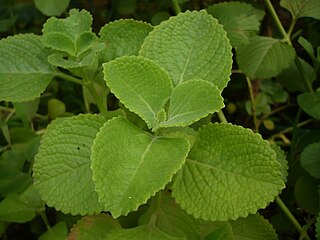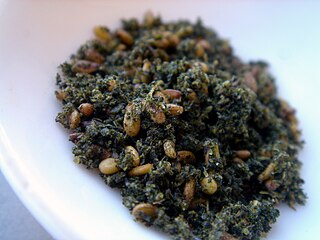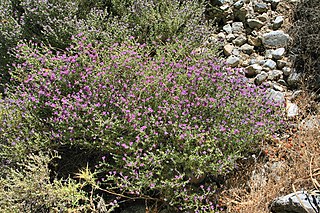
Satureja is a genus of aromatic plants of the family Lamiaceae, related to rosemary and thyme. It is native to North Africa, southern and southeastern Europe, the Middle East, and Central Asia. A few New World species were formerly included in Satureja, but they have all been moved to other genera. Several species are cultivated as culinary herbs called savory, and they have become established in the wild in a few places.

The Jerusalem Talmud or Palestinian Talmud, also known as the Talmud of the Land of Israel, is a collection of rabbinic notes on the second-century Jewish oral tradition known as the Mishnah. Naming this version of the Talmud after Palestine or the Land of Israel—rather than Jerusalem—is considered more accurate, as the text originated mainly from Galilee in Byzantine Palaestina Secunda rather than from Jerusalem, where no Jews lived at the time.

Coleus amboinicus, synonym Plectranthus amboinicus, is a semi-succulent perennial plant in the family Lamiaceae with a pungent oregano-like flavor and odor. Coleus amboinicus is considered to be native to parts of Africa, the Arabian Peninsula, and India, although it is widely cultivated and naturalized elsewhere in the tropics where it is used as a spice and ornamental plant. Common names in English include Indian borage, country borage, French thyme, Indian mint, Mexican mint, Cuban oregano, soup mint, Spanish thyme. The species epithet, amboinicus refers to Ambon Island, in Indonesia, where it was apparently encountered and described by João de Loureiro (1717–1791).

Za'atar is a culinary herb or family of herbs. It is also the name of a spice mixture that includes the herb along with toasted sesame seeds, dried sumac, often salt, and other spices. As a family of related Levantine herbs, it contains plants from the genera Origanum (oregano), Calamintha, Thymus, and Satureja (savory) plants. The name za'atar alone most properly applies to Origanum syriacum, considered in biblical scholarship to be the ezov of the Hebrew Bible, often translated as hyssop but distinct from modern Hyssopus officinalis.

Satureja montana, is a perennial, semi-evergreen herb in the family Lamiaceae, native to warm temperate regions of southern Europe, the Mediterranean, and Africa. It has dark green leaves and summer flowers ranging from pale lavender, or pink to white. The closely related summer savory is an annual plant.

Summer savory is among the best known of the savory genus. It is an annual, but otherwise is similar in use and flavor to the perennial winter savory. It is used more often than winter savory, which has a slightly more bitter flavor.
Carvacrol, or cymophenol, C6H3(CH3)(OH)C3H7, is a monoterpenoid phenol. It has a characteristic pungent, warm odor of oregano.
Terumot is the sixth tractate of Seder Zeraim of the Mishnah and of the Jerusalem Talmud. This tractate discusses the laws of teruma, a gift of produce that an Israelite farmer was required to set aside and give to a kohen (priest). There were two kinds of terumot given to the priest: the regular heave-offering, known also as the terumah gedolah, which the Israelites were required to give to the priest from the produce of their fields; the other was the terumat ma'aser, namely, the gift that the Levites were required to put aside for the priests from the tithe which ordinary Israelites had been required to give to them.

Shevi'it is the fifth tractate of Seder Zeraim of the Mishnah, dealing with the laws of leaving the fields of the Land of Israel to lie fallow every seventh year; the laws concerning which produce may, or may not be eaten during the Sabbatical year; and the cancellation of debts and the rabbinical ordinance established to allow a creditor to reclaim a debt after the Sabbatical year (Prozbul).

The tithe is specifically mentioned in the Books of Leviticus, Numbers and Deuteronomy. The tithe system was organized in a seven-year cycle, the seventh-year corresponding to the Shemittah-cycle in which year tithes were broken-off, and in every third and sixth-year of this cycle the second tithe replaced with the poor man's tithe. These tithes were akin to taxes for the people of Israel and were mandatory, not optional giving. This tithe was distributed locally "within thy gates" to support the Levites and assist the poor. Every year, Bikkurim, terumah, ma'aser rishon and terumat ma'aser were separated from the grain, wine and oil. Initially, the commandment to separate tithes from one's produce only applied when the entire nation of Israel had settled in the Land of Israel. The Returnees from the Babylonian exile who had resettled the country were a Jewish minority, and who, although they were not obligated to tithe their produce, put themselves under a voluntary bind to do so, and which practice became obligatory upon all.

Cryptocarya agathophylla is a member of the laurel family, Lauraceae, and originates in Madagascar.

Origanum syriacum; syn. Majorana syriaca, bible hyssop, Biblical-hyssop, Lebanese oregano or Syrian oregano, is an aromatic perennial herb in the mint family, Lamiaceae.

Thymus pannonicus, known by its common name Hungarian thyme or Eurasian thyme, is a perennial herbaceous plant, distributed in central and eastern Europe and Russia. It grows over open dry meadows, grasslands, and rocks.

Hyssopus officinalis or hyssop is a shrub in the Lamiaceae or mint family native to Southern Europe, the Middle East, and the region surrounding the Caspian Sea. Due to its purported properties as an antiseptic, cough reliever, and expectorant, it has been used in traditional herbal medicine.
Kil'ayim are the prohibitions in Jewish law which proscribe the planting of certain mixtures of seeds, grafting, the mixing of plants in vineyards, the crossbreeding of animals, the formation of a team in which different kinds of animals work together, and the mixing of wool with linen in garments.

Thymus capitatus is a compact, woody perennial native to Mediterranean Europe and Turkey, more commonly known as conehead thyme, Persian-hyssop and Spanish oregano. It is also known under the name Thymbra capitata.

The Mosaic of Reḥob, is a late 3rd–6th century CE mosaic discovered in 1973. The mosaic, written in late Mishnaic Hebrew, describes the geography and agricultural rules of the local Jews of the era. It was inlaid in the floor of the foyer or narthex of an ancient synagogue near Tel Rehov, 4.5 kilometres (2.8 mi) south of Beit She'an and about 6.5 kilometres (4.0 mi) west of the Jordan River. The mosaic contains the longest written text yet discovered in any Hebrew mosaic in Israel, and also the oldest known Talmudic text.

Nathan ben Abraham, known also by the epithet President of the Academy in the Land of Israel, was an 11th-century rabbi and exegete of the Mishnah who lived in Ramla, in the Jund Filastin district of the Fatimid Caliphate. He was the author of the first known commentary covering the entire Mishnah.

Wild edible plants in the geographical region known as Palestine, like in other countries, have been used to sustain life in periods of scarcity and famine, or else simply used as a supplementary food source for additional nourishment and pleasure. The diverse flora of Israel and Palestine offers a wide-range of plants suitable for human consumption, many of which have a long history of usage in the daily cuisines of its native peoples.

A fig-cake is a mass or lump of dried and compressed figs, usually formed by a mold into a round or square block for storage, or for selling in the marketplace for human consumption. The fig-cake is not a literal cake made as a pastry with a dough batter, but rather a thick and often hardened paste of dried and pressed figs made into a loaf, sold by weight and eaten as food in Mediterranean countries and throughout the Near East. It is named "cake" only for its compacted shape when several are pounded and pressed together in a mold.

















